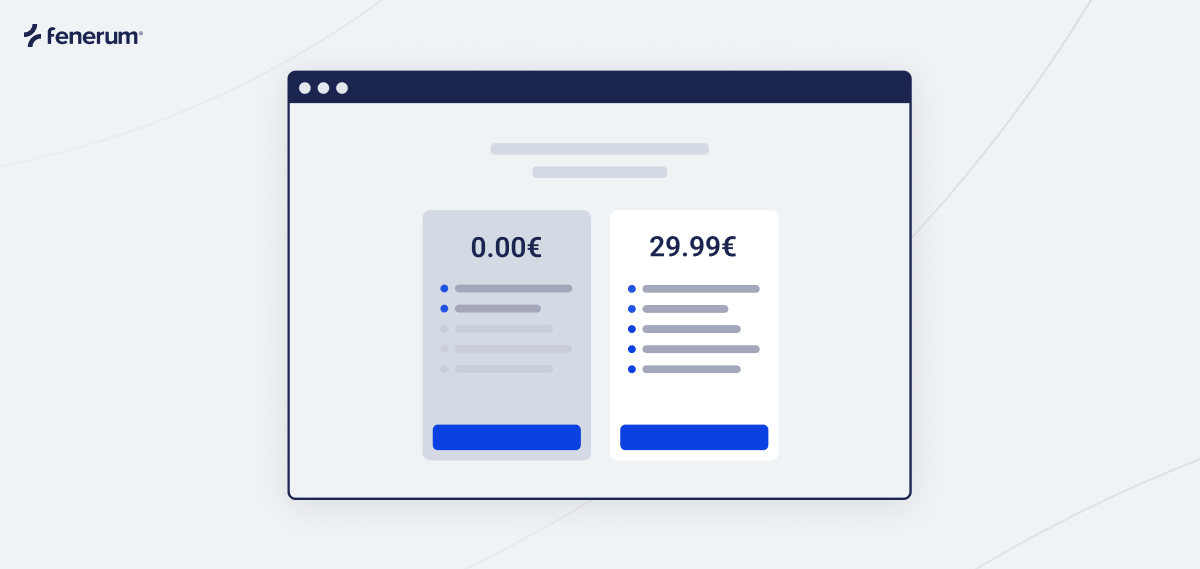What is Freemium?
Freemium is a business model where companies provide a basic version of their product or service for free while charging for premium features, advanced tools, or additional services. The term "freemium" is a combination of "free" and " premium," representing this dual-tier approach.
 Example of a freemium pricing model.
Example of a freemium pricing model.
The freemium business model is widely used in SaaS (Software as a Service), mobile apps, and digital platforms. By allowing users to access a free tier, companies can acquire customers more easily and encourage them to upgrade to a paid plan.
Many successful SaaS freemium models, such as those from Slack, Dropbox, and Spotify, demonstrate how businesses can attract users with free services and convert them into paying customers.
How the freemium business model works
The freemium business model operates on a simple premise: attract users with free access and convert a percentage of them into paying customers. It typically includes:
- Free Tier: Users get basic features or limited access for free.
- Premium Tier: Additional functionalities, higher usage limits, or exclusive tools are unlocked through a paid subscription.
- Upselling Strategy: Companies encourage users to upgrade by showcasing the value of premium features.
For a SaaS freemium business, a well-structured pricing strategy ensures that the free plan provides enough value to draw users in without making premium upgrades unnecessary.
Is the freemium model right for your SaaS?
The freemium business model can be a powerful growth strategy, but is it the right fit for your SaaS company? While it offers significant advantages, it also comes with challenges that must be carefully managed.
Advantages of freemium
Freemium can be a game-changer for SaaS businesses looking to expand their user base and drive long-term revenue. Here’s why it works:
- Lower Customer Acquisition Costs (CAC): By offering a free plan, you remove barriers to entry, making it easier to attract new users with minimal upfront marketing spend.
- Viral Growth Potential: Happy free users often spread the word, leading to organic referrals and exponential growth.
- Built-in Conversion Funnel: A well-structured freemium model gradually nudges users toward premium upgrades by demonstrating value over time.
- Wider Market Reach: You can engage a broader audience, including those hesitant to commit financially upfront, increasing your potential customer pool.
- Flexible Monetization Options: Businesses can experiment with multiple revenue strategies, such as tiered pricing, feature-based upgrades, or additional service add-ons.
Challenges to consider
While the freemium approach offers great opportunities, it’s not without risks. Companies must be mindful of these common challenges:
- Low Conversion Rates: Many free users may never upgrade, making monetization difficult without a strong value-driven upgrade strategy.
- High Operational Costs: Maintaining a large free-user base requires significant infrastructure, customer support, and ongoing maintenance.
- Support and Resource Strain: Offering free access means more users, which can lead to increased customer support demands and potential service bottlenecks.
If your SaaS product can provide continuous value, has a clear upgrade path, and can sustain a large free-user base, the freemium model can be a highly effective strategy. However, if operational costs outweigh potential revenue, or conversion rates remain too low, a free trial or other pricing models may be a better fit.
Freemium vs. free trial
The freemium business model is often confused with the free trial model, but they serve different purposes and target different types of users. Understanding these distinctions can help businesses choose the right approach for customer acquisition and conversion.
What is a free trial?
A free trial is a limited-time offer that gives users full access to a product’s premium features before requiring payment. It is designed to give potential customers a taste of the complete experience, helping them evaluate whether the product meets their needs before committing to a subscription.
Free trials are commonly used by SaaS companies with complex or high-value products that require hands-on experience to demonstrate their full potential. The goal is to convert users into paying customers before the trial period expires.
What is the key differences?
| Feature | Freemium Business Model | Free Trial Model |
|---|---|---|
| Access Duration | Unlimited | Limited (e.g., 7-30 days) |
| Feature Limitation | Limited features remain free | Full access for a short period |
| Conversion Strategy | Encourages long-term use and upgrades | Converts users before trial ends |
| Best for | SaaS, apps, and digital services with ongoing engagement | High-value SaaS products requiring full-feature access |
Conclusion
The freemium business model is a powerful way to acquire users, build brand loyalty, and drive revenue growth especially in SaaS. When implemented correctly, freemium allows businesses to expand their user base and increase conversions through strategic upselling.
If your SaaS product has strong engagement potential, relies on network effects, and can support a large free-user base without incurring excessive costs, freemium can be a highly effective growth strategy. However, if your product is high-touch, expensive to maintain, or requires full-feature access to deliver value, a free trial model may be a better fit.
